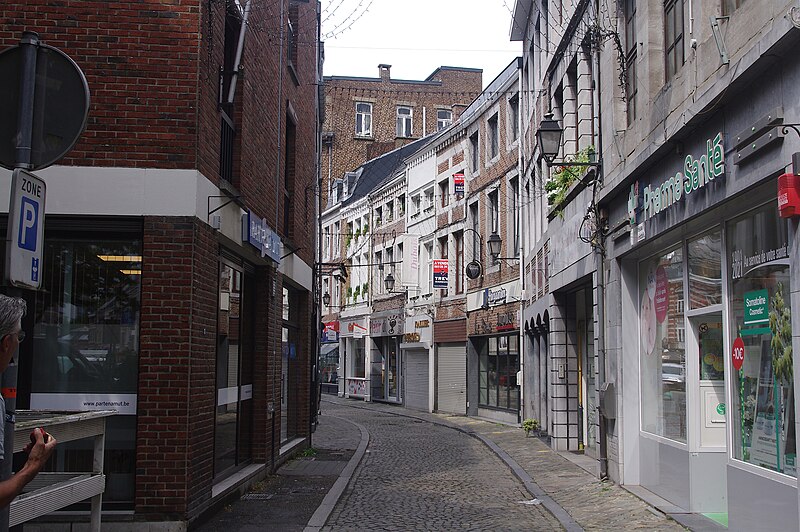File:Huy - Rue des Brasseurs.jpg

Original file (2,048 × 1,361 pixels, file size: 1.34 MB, MIME type: image/jpeg)
Captions
Captions
Summary[edit]
| DescriptionHuy - Rue des Brasseurs.jpg |
English: Huy
Huy is a city and municipality of Wallonia located in the province of Liège, Belgium. Huy lies along the river Meuse, at the mouth of the small river Hoyoux. It is in the "sillon industriel", the former industrial backbone of Wallonia. The first village originated around the Roman castrum, an early fortress located on the right bank of the river Meuse. The village was evangelized by Saint Domitian, bishop of Tongeren in the 6th century and the town is mentioned for the first time in a 7th-century testament (as Hoius vicus, taking its name from the river Hoyoux). In the early Middle Ages, Huy was one of the most prosperous cities on the Meuse, with a flourishing economy based mostly on metallurgy, but also on tanning, sculpting, woodworking, and wine-making. In the 10th century, Huy was promoted to county status, but soon became part of the Prince-Bishopric of Liège, with which it would share its history for more than eight centuries. Huy was the recipient of the first historically known charter north of the Alps, confirming it as a city in 1066. It is around that time that Peter the Hermit harangued the locals and persuaded them to participate in the First Crusade, having already participated himself in the People's Crusade and the Rhineland massacres in 1096. In the 13th and 14th centuries, the economy boomed thanks to the cloth industry. The castle on a hill right in the middle of town, was used in times of war and strengthened accordingly. By the 15th century, it had become the symbol of the city. The following two centuries, however, witnessed a gradual decline in the city's fortunes, due in large part to the strategic value of its location on the Meuse. In the latter part of the 17th century, Louis XIV's wars caused the city to be repeatedly attacked and put to the sword, to the point that the frustrated inhabitants dismantled their own castle, source of their miseries, in 1715. A new fortress was built by the Dutch in 1818 at the same strategic location above the town. The 19th century was a period of relative prosperity based on the paper and other industries. The decline of heavy industry in the 20th century was felt here, as in other parts of Wallonia. Today, the city has started to prosper again, thanks in part to its tin products and tourist activity. In 1970, the Tihange Nuclear Power Station was built nearby. Source: en.wikipedia.org/wiki/Huy |
| Date | |
| Source | https://www.flickr.com/photos/rutgervandermaar/51613621677/ |
| Author | Rutger van der Maar |
Licensing[edit]
- You are free:
- to share – to copy, distribute and transmit the work
- to remix – to adapt the work
- Under the following conditions:
- attribution – You must give appropriate credit, provide a link to the license, and indicate if changes were made. You may do so in any reasonable manner, but not in any way that suggests the licensor endorses you or your use.
| This image was originally posted to Flickr by Rutger van der Maar at https://flickr.com/photos/83468718@N06/51613621677. It was reviewed on 16 January 2022 by FlickreviewR 2 and was confirmed to be licensed under the terms of the cc-by-2.0. |
16 January 2022
File history
Click on a date/time to view the file as it appeared at that time.
| Date/Time | Thumbnail | Dimensions | User | Comment | |
|---|---|---|---|---|---|
| current | 15:58, 16 January 2022 |  | 2,048 × 1,361 (1.34 MB) | DestinationFearFan (talk | contribs) | Uploaded a work by Rutger van der Maar from https://www.flickr.com/photos/rutgervandermaar/51613621677/ with UploadWizard |
You cannot overwrite this file.
File usage on Commons
The following page uses this file:
Metadata
This file contains additional information such as Exif metadata which may have been added by the digital camera, scanner, or software program used to create or digitize it. If the file has been modified from its original state, some details such as the timestamp may not fully reflect those of the original file. The timestamp is only as accurate as the clock in the camera, and it may be completely wrong.
| Camera manufacturer | PENTAX |
|---|---|
| Camera model | PENTAX K-r |
| Exposure time | 1/125 sec (0.008) |
| F-number | f/10 |
| ISO speed rating | 200 |
| Date and time of data generation | 13:56, 23 August 2021 |
| Lens focal length | 28.13 mm |
| Orientation | Normal |
| Horizontal resolution | 300 dpi |
| Vertical resolution | 300 dpi |
| Software used | darktable 3.6.1+6~g4bc866924 |
| File change date and time | 16:45, 21 October 2021 |
| Y and C positioning | Co-sited |
| Exposure Program | Shutter priority |
| Exif version | 2.3 |
| Date and time of digitizing | 13:56, 23 August 2021 |
| Meaning of each component |
|
| APEX exposure bias | 0 |
| Metering mode | Pattern |
| Flash | Flash did not fire, compulsory flash suppression |
| Supported Flashpix version | 1 |
| Color space | sRGB |
| Sensing method | One-chip color area sensor |
| File source | Digital still camera |
| Scene type | A directly photographed image |
| Custom image processing | Normal process |
| Exposure mode | Auto exposure |
| White balance | Auto white balance |
| Focal length in 35 mm film | 42 mm |
| Scene capture type | Standard |
| Contrast | Hard |
| Saturation | Normal |
| Sharpness | Hard |
| Subject distance range | Distant view |
| Rating (out of 5) | 1 |